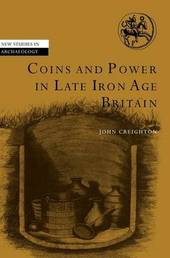
|
Coins and Power in Late Iron Age Britain
Hardback
Main Details
| Title |
Coins and Power in Late Iron Age Britain
|
| Authors and Contributors |
By (author) John Creighton
|
| Series | New Studies in Archaeology |
|---|
| Physical Properties |
| Format:Hardback | | Pages:266 | | Dimensions(mm): Height 244,Width 170 |
|
| Category/Genre | British and Irish History
World history - BCE to c 500 CE
Archaeology by period and region |
|---|
| ISBN/Barcode |
9780521772075
|
| Classifications | Dewey:936.1 |
|---|
| Audience | | Professional & Vocational | | Tertiary Education (US: College) | |
|---|
| Illustrations |
2 Tables, unspecified; 6 Maps; 45 Halftones, unspecified
|
|
Publishing Details |
| Publisher |
Cambridge University Press
|
| Imprint |
Cambridge University Press
|
| Publication Date |
6 July 2000 |
| Publication Country |
United Kingdom
|
Description
Cunobelin, Shakespeare's Cymbeline, ruled much of Southeast Britain in the years before Claudius' legions arrived, creating the Roman Province of Britannia. But what do we know of him and his rule, and that of competing dynasties in Southeast Britain? This book examines the background to these, the first individuals in British history. It explores the way in which rulers bolstered their power through the use of imagery on coins, myths, language, and material culture. After the visit of Caesar in 55 and 54 BC, the shadow of Rome played a fundamental role in this process. Combining the archaeological, literary and numismatic evidence, John Creighton paints a vivid picture of how people in Late Iron Age Britain reacted to the changing world around them.
Reviews'... this is a book which will merit much picking over and debate ... it is one which could fundamentally change our view of the Late Iron Age and the beginning of Roman Britain.' Cambridge Archaeological Journal 'This book represents a major shift in interpretation away from the traditional picture ... this is a book which will merit much picking over and debate ... it is one which could fundamentally change our view of the Late Iron Age and the beginning of Roman Britain.' Cambridge Archaeological Journal
|